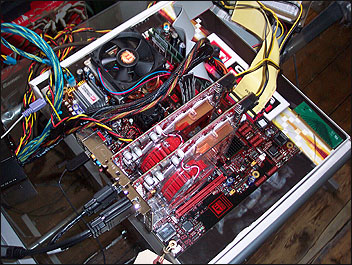Page 3
ATI Crossfire
ATI has had the dubious benefit of seeing NVIDIA's SLI technology flourish from an enthusiast-only venture into, now, a mainstream product. Multi-GPU technology is big business, especially if you can successfully market and sell a certified motherboard and 2 GPUs at one time. ATI's long-awaited response comes in the form of CrossFire, it's very own multi-GPU architecture that's just about to hit the retail shelves.
CrossFire shares a number of common attributes with SLI. The first is the need for a specific PCI-Express-based motherboard on which to run 2 (or more, theoretically) CrossFire cards. Right now, that falls on the shoulders of ATI's Xpress 200 CrossFire Edition, available, much like SLI, in AMD S939 and Intel S775 versions, but there's no reason why other boards with dual x16 electrical slots (Intel D955XBK, for example) can't run it just fine; it's a matter of ATI validation. The first real point of departure between these two competing multi-GPU technologies, however, lies in the graphics hardware you'll need to invest in. Currently, CrossFire is supported on the X1000 and X800 families, and there's no obvious reason, other than financial, why it won't be implemented for cheaper models. On a software front, CrossFire supports all 3D games automatically, although there's little control over the settings.
ATI's CrossFire system still requires a couple of PCI-Express-based cards to work correctly but one, designated master, isn't your usual run-of-the-mill variety, unlike NVIDIA's SLI. The master card resides in the primary PCIe x16 slot and has a dedicated compositing chip on board, so you simply cannot lash, for example, a couple of Radeon X1800 XLs together and hope they'll work; they wont! The compositing chip then takes a frame from the primary card on which it is located, mixes it with the partial frame from the slave card, attached via a DVI cable and connected to a high density input connector on the master card. The end result is that the final, complete rendering from the master card that is usually located below the slave in a CrossFire motherboard is outputted, via DVI, to the display of your choice.
Once the hardware elements have been setup and associated software installed, CrossFire usage is as transparent as SLI. CrossFire's main rendering modes fall under the names of SuperTiling, Scissor, and AFR modes, which are generally chosen by the driver, depending upon application used. SuperTiling splits the entire frame up into tiles with 32x32 pixels in each, and each card takes half the tiles and renders them individually. The slave's rendered tiles are then sent over to the master card via the DVI link, composited with the rendering from the master card and sent out for display. This is the most likely method of rendering with D3D titles.
ATI's Scissor mode is roughly analagous to NVIDIA's split-frame rendering (SFR), where the frame is broken up into portions and each card renders the top (master) or bottom (slave part). Alternative-frame rendering (AFR) is exactly what it sounds like, and is very similar to NVIDIA's. There's also what ATI terms a Super AA mode, which combines the antialiasing output from both cards, through the compositing chip, and produces an output that can combine multi- and super-sampling. 12x Super AA, for instance, is just 6x AA multisampling on each card, combined. Data in Super AA mode is sent not via the DVI link as with Scissor and AFR modes, but rather over the PCIe bus. ATI's Super AA mode has to be enabled manually through the control panel.
NVIDIA also has an SLI AA mode, right up to a 'mine-is-bigger-than-yours' 16x, which is simply the 2 cards running at 8xS. Remember, though, that Super AA doesn't impact positively upon games performance; it just makes them look prettier. Multi-GPU AA, then, is highly useful in instances where games are more GPU-bound. Half-Life 2 springs back in to mind.
Overall performance from CrossFire, tested with X850-class hardware, and SLI can be found in our detailed look here. As one would expect, multi-GPU setups come into their own once the application becomes GPU-limited, usually from a combination of high resolutions and copious amounts of image enhancement (antialiasing and anisotropic filtering). Performance, too, is almost double a single card's in the most extreme situations.

Note the lack of a inter-GPU connector on CrossFire, and the way in which GPUs are tied together.
Which is better?
Whereas NVIDIA's SLI requires that two identical cards for multi-GPU operation, ATI's doesn't. You're free to add in a slave card that's from the same general family, irrespective of manufacturer. CrossFire's in its infancy and has had a few problems, such as the inability to run at resolutions greater than 1600x1200 @ 60Hz (or 1920x1200 @ 52Hz, widescreen) on a CRT, simply because information is transferred over a DVI interface. If you need that kind of resolution and don't want to switch to a digital display, the chances are your eyes may not thank you for flicker-induced headaches! NVIDIA has been ploughing the SLI furrow for around 18 months now and has had that time to deliver a seamless package. ATI's late in getting into the game and playing catchup at a fast pace. It really needs to have a complete range of master cards and compatible motherboards out in force right now.
Both competing multi-GPU solutions can offer framerates and image quality that unobtainable on a single card. Both, though, place certain restrictions upon the choice of componentry. NVIDIA requires the use of identical GPUs, and ATI's system requires a special master card with built-in compositing chip. Both, too, currently require certified motherboards, so upgrading to a multi-GPU machine will require wholesale changes, especially if your present system is an older AGP-based affair.
If ultra-high framerates are what you hanker after, multi-GPU technology is the way to go. Given a direct choice between SLI and CrossFire, our nod would currently go to NVIDIA's SLI. It's been around longer, and it's available in all flavours immediately.













